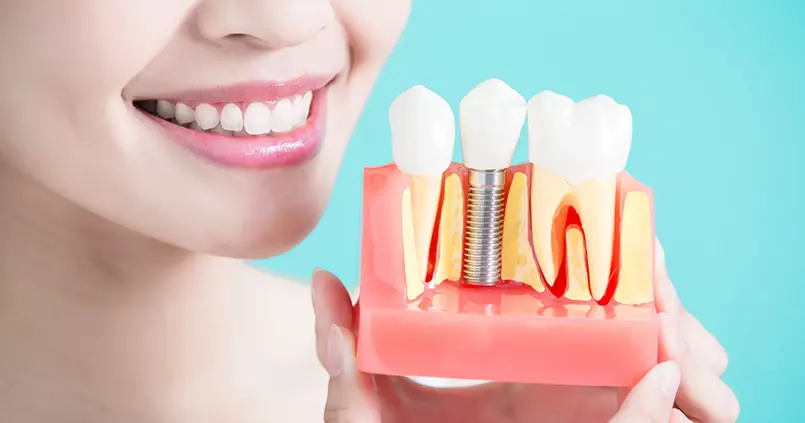Dental Implant Stats for 2024-2025
- 9% of all dental implant cases are for patients between 65-74 years old – Source
- 93% of all U.S. dental implants are titanium – Source
- More than over 150 million people in the U.S. have missing teeth – Source
- The D2740 implant code is for high-end porcelain and ceramic crowns – Source
- Chandler dental implants costs on average $2,000-$4,500 per tooth – Source
- The average failure rate for a dental implant is 3.1% worldwide and 6% in the U.S. – Source
- In 2024, about 3 million Americans have a dental implant. – Source
- Teeth in a day or 24-hour dental implants mean it takes about 24 hours of work to complete a procedure from start to finish. This is cumulative and not all in 1 calendar day – Source
- The cumulative prosthetic survival rate of All-On-4 dental implants is 98.8% – Source
- The total 2024-2025 dental implant market worldwide is roughly $8 billion. – Source

Key Dental Implant Facts and Trends
The provided implant dentistry stats offer a comprehensive overview of 2024-2025 dental implant trends with significant implications for patients, doctors, and dental practices.
For Patients:
- Age Demographics: With 12.9% of dental implants being for individuals aged 65-74, it indicates a high demand among seniors, emphasizing the importance of dental implants in improving the quality of life for the elderly.
- Material Preference: The dominance of titanium in 93% of U.S. dental implants highlights its reliability and patient preference, guiding patients in their choices.
- Prevalence of Missing Teeth: With over 150 million people in the U.S. having missing teeth, the demand for dental implants is substantial, underscoring a widespread need for dental restoration solutions.
- Cost Considerations: The cost of dental implants, averaging between $2,000 and $4,500 per tooth in Chandler, points to a significant investment for patients, emphasizing the need for financial planning or seeking insurance coverage that accommodates such procedures.
- Procedure Expectations: The concept of “teeth in a day” clarifies patient expectations, indicating a streamlined process that, while not completed within a calendar day, represents a cumulative effort to expedite dental restoration.
For Doctors:
- Procedural Success: The average failure rate of dental implants, 3.1% worldwide and 6% in the U.S., suggests a generally high success rate but also highlights the importance of advanced training and precision in implant placement to minimize failures.
- Technological Advances: The high survival rate of 98.8% for all-on-4 dental implants and the widespread use of titanium implants underscore the advancements in dental implant technology, encouraging ongoing education and adaptation to new methods.
- Market Opportunities: The growing number of Americans with dental implants, projected to be about 3 million in 2024, alongside a dental implant market worth roughly $8 billion, indicates a booming sector with substantial opportunities for dental professionals.

For Dental Practices:
- Service Diversification: The statistics suggest a need for practices to diversify their services to include a range of dental implant options, catering to the significant portion of the population with missing teeth and the growing preference for advanced materials like porcelain and ceramic crowns (D2740).
- Insurance and Cost Management: The variation in dental implant costs necessitates transparent communication with patients about financial expectations and insurance coverage, including coding nuances like the D2740 for high-end crowns.
- Market Growth: The expanding market for dental implants points to the importance of dental practices staying abreast of industry trends, technological advancements, and patient demographics to strategically position themselves in a competitive market.
These facts highlight areas for growth, patient education, and the importance of adopting new technologies and practices to meet the population’s evolving needs for dentists.

Cited Sources
- https://pubmed.ncbi.nlm.nih.gov/30075090/
- https://totalfreedomdentalimplants.com/dental-implant-statistics/
- https://connect.aaid-implant.org/blog/trends-in-dental-implants-2022
- https://www.dentistryiq.com/front-office/insurance-coding-and-tips/article/14213837/coding-with-kyle-d2740porcelain-and-ceramic-crowns
- https://www.thebusinessresearchcompany.com/report/dental-implants-global-market-report
- https://www.jomos.org/articles/mbcb/full_html/2022/02/mbcb210065/mbcb210065.html
- https://amarillodentureclinic.com/blog/2021/07/14/understanding-dental-implant-statistics/
- https://connect.aaid-implant.org/blog/teeth-in-a-day-myth-or-reality
- https://drlampee.com/dental-implant-facts/

